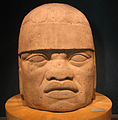San Lorenzo Tenochtitlan
San Lorenzo Tenochtitlan is the complex name for three closely spaced ceremonial centers of the Olmecs in the state of Veracruz ( Mexico ), which were discovered near the villages of San Lorenzo Tenochtitlan and Portero Nuevo .
location
The three archaeological sites are located close to each other about 80 km (driving distance) southwest of the port city of Coatzacoalcos in the area of the municipality ( municipio ) Texistepec at about 25 to 50 m above sea level. d. M.
history
San Lorenzo is considered to be the oldest ceremonial center in Mesoamerica to date . Between 1150 and 900 BC BC temples with steles and sculptures as well as several colossal heads were built here . Around 900 BC The site was destroyed and experienced between 600 and 400 BC. A new settlement. Excavations began in the 1940s.
architecture
In San Lorenzo an approx. 1200 m long, 700 m wide and approx. 50 m high plateau - mostly built up by human hands - was discovered; It is unclear whether one or even more temple huts stood on it, whereas the existence of residential huts made of woven branches with clay plastering can be assumed. The outside of the artificial hill was not or only loosely paved with stones and had to be renewed again and again after heavy or prolonged rainfall. At the foot of the plateau was a settlement of huts, which must have had a certain resemblance to the Mayan huts . In the area there were several ponds that ensured the water supply; A drainage system made of stones was also identified. There was also a ball playground .
In the 1980s, an astronomical relationship was recognized between San Lorenzo, the Zempoaltepec volcano, and the winter solstice .
Sculptures
Colossal heads

Several colossal heads were excavated in San Lorenzo as early as the 1940s; up to 1994 more were discovered - now there are a total of 10 exhibited in various museums in Mexico. They are between 1.65 m and 2.85 m tall and weigh about 6 to 25 tons. According to recent studies, all of these heads were made within a period of 100 to 150 years from basalt lava balls or blocks that were probably ejected from the volcanic mountains of the Sierra de los Tuxtlas around 8 million years ago .
| monument | local name | discovery | Height (m) | Weight (t) | museum |
|---|---|---|---|---|---|
| Colossal Head 1 | Monument 1 | 1945 | 2.84 | 25.3 | Xalapa |
| Colossal Head 2 | Monument 2 | 1945 | 2.69 | 20th | Mexico City |
| Colossal Head 3 | Monument 3 | 1946 | 1.78 | 9.4 | Xalapa |
| Colossal Head 4 | Monument 4 | 1946 | 1.78 | 6th | Xalapa |
| Colossal Head 5 | Monument 5 | 1946 | 1.86 | 11.6 | Xalapa |
| Colossal Head 6 | Monument 17 | 1965 | 1.67 | 8-10 | Mexico City |
| Colossal Head 7 | Monument 53 | 2.70 | 18th | Xalapa | |
| Colossal Head 8 | Monument 61 | 1968 | 2.20 | 13 | Xalapa |
| Colossal Head 9 | Monument 66 | 1982 | 1.65 | Xalapa | |
| Colossal Head 10 | Monument 89 | 1994 | 1.80 | San Lorenzo |
Other
Another stele-like head also comes from San Lorenzo. But other sculptures were also found, among which a seated human jaguar figure with a headdress and breast shield is particularly noteworthy. The structures known as "altar" or "throne", which present a human figure on the front, are puzzling. Even stranger are hundreds of thousands of approximately 1.5 cm long stones made of ilmenite , in which mostly 3 holes have been drilled. For what purpose these objects may have served is completely unclear.
museum
In 1995 a museum was inaugurated near San Lorenzo, which shows the last colossal head found here as well as other figurative and non-figurative objects.
See also
literature
- Gisela Ermel: The riddle of San Lorenzo. In: Fabulous times. 2009 (with references to references)
- Stacey Symonds, Ann Cyphers, Roberto Lunagómez: Asentamiento prehispánico en San Lorenzo Tenochtitlán. UNAM 2002, ISBN 968-36-9809-3 .
Web links
- San Lorenzo Tenochtitlan - Info (INAH, Spanish)
- Museum San Lorenzo - Info (INAH, Spanish)
- San Lorenzo Tenochtitlan, Museum - Photos + Info (English)
- Olmec Colossal Heads - Photos + Info (English)
- San Lorenzo Tenochtitlan, man-jaguar sculpture - photo + info (Spanish)
Coordinates: 17 ° 45 ′ 15 " N , 94 ° 45 ′ 40" W.







